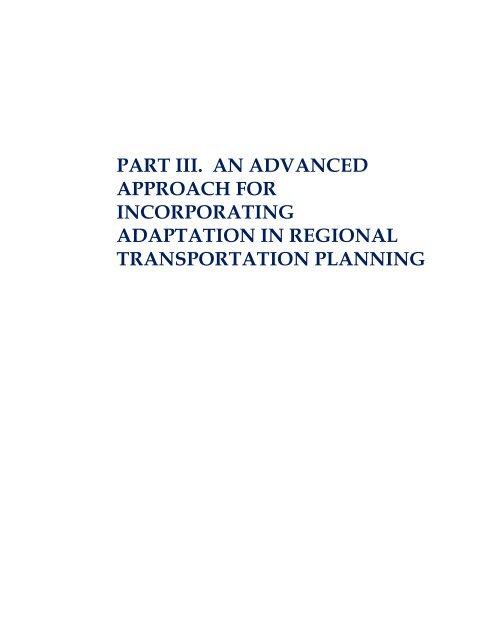addressing climate change adaptation in regional transportation plans
addressing climate change adaptation in regional transportation plans addressing climate change adaptation in regional transportation plans
Addressing Climate Change Adaptation in Regional Transportation PlansA Guide for California MPOs and RTPAs6.2 ADAPTATION PROJECTS ELEVATED DUETO EXTREME WEATHER EVENTSThe impetus for planning for climate adaptation can be instigated by majorextreme weather events or natural disasters that have the potential to becomemore frequent and/or more severe with climate change.For example, the Confusion Hill Bypass in Mendocino County is an example ofhow a project can be accelerated due to extreme weather events. The ConfusionHill Bridges are a pair of high bridges carrying two lanes of U.S. Highway 101over the South Fork Eel River in Mendocino County in northern California. Theold route weaved through a river canyon that was closed yearly due tolandslides. Between 1997 and 2006, landslides would become an annualoccurrence, with earth and rocks covering the road and bringing traffic andbusiness to a halt. Caltrans spent more than $33 million in the nine-year periodclearing debris and repairing the road under Confusion Hill. Because of the highcosts of maintaining the old section and potential safety issues that perpetuallyposed a risk to travelers, Caltrans and the County secured $65 million inemergency relief funding from the FHWA and constructed the Bypass,completed in 2009.Another example is the proposal by Caltrans to move three miles of Highway 1in Big Sur as far as 475 feet inland in order to protect against expected clifferosion underneath the current stretch of highway. In 2011, a landslide closedHighway 1 near Big Sur in Monterey County, a major regional and recreationroute, forcing motorists to make a long inland detour using U.S. Highway 101.The two-month closure prompted Caltrans to review this stretch of roadway toconsider the most relocation as a form of adaptation; in this case, an extreme andcostly adaptation option.These examples reflect how existing extreme weather events already posehazards to the regional transportation system. Using these examples as extremepossibilities can help provide insight into the types of impacts that climatechange may intensify.6-6 Cambridge Systematics, Inc.
PART III. AN ADVANCEDAPPROACH FORINCORPORATINGADAPTATION IN REGIONALTRANSPORTATION PLANNING
- Page 22 and 23: Addressing Climate Change Adaptatio
- Page 24 and 25: Addressing Climate Change Adaptatio
- Page 26 and 27: Addressing Climate Change Adaptatio
- Page 28 and 29: Addressing Climate Change Adaptatio
- Page 30 and 31: Addressing Climate Change Adaptatio
- Page 32 and 33: Addressing Climate Change Adaptatio
- Page 35 and 36: Addressing Climate Change Adaptatio
- Page 37 and 38: Addressing Climate Change Adaptatio
- Page 39 and 40: Addressing Climate Change Adaptatio
- Page 41 and 42: Addressing Climate Change Adaptatio
- Page 43 and 44: Addressing Climate Change Adaptatio
- Page 45 and 46: Addressing Climate Change Adaptatio
- Page 47: Addressing Climate Change Adaptatio
- Page 50 and 51: Addressing Climate Change Adaptatio
- Page 52 and 53: Addressing Climate Change Adaptatio
- Page 54 and 55: Addressing Climate Change Adaptatio
- Page 56 and 57: Addressing Climate Change Adaptatio
- Page 58 and 59: Addressing Climate Change Adaptatio
- Page 61 and 62: Addressing Climate Change Adaptatio
- Page 63 and 64: Addressing Climate Change Adaptatio
- Page 65: Addressing Climate Change Adaptatio
- Page 68 and 69: Addressing Climate Change Adaptatio
- Page 70 and 71: Addressing Climate Change Adaptatio
- Page 75 and 76: Addressing Climate Change Adaptatio
- Page 77 and 78: Addressing Climate Change Adaptatio
- Page 79 and 80: Addressing Climate Change Adaptatio
- Page 81 and 82: Addressing Climate Change Adaptatio
- Page 83: Addressing Climate Change Adaptatio
- Page 86 and 87: Addressing Climate Change Adaptatio
- Page 88 and 89: Addressing Climate Change Adaptatio
- Page 90 and 91: Addressing Climate Change Adaptatio
- Page 92 and 93: Addressing Climate Change Adaptatio
- Page 94 and 95: Addressing Climate Change Adaptatio
- Page 96 and 97: Addressing Climate Change Adaptatio
- Page 98 and 99: Addressing Climate Change Adaptatio
- Page 101 and 102: Addressing Climate Change Adaptatio
- Page 103 and 104: Addressing Climate Change Adaptatio
- Page 105 and 106: Addressing Climate Change Adaptatio
- Page 107 and 108: Addressing Climate Change Adaptatio
- Page 109 and 110: Addressing Climate Change Adaptatio
- Page 111 and 112: Addressing Climate Change Adaptatio
- Page 113 and 114: Addressing Climate Change Adaptatio
- Page 115 and 116: Addressing Climate Change Adaptatio
- Page 117 and 118: Addressing Climate Change Adaptatio
- Page 119 and 120: Addressing Climate Change Adaptatio
- Page 121 and 122: Addressing Climate Change Adaptatio
PART III. AN ADVANCEDAPPROACH FORINCORPORATINGADAPTATION IN REGIONALTRANSPORTATION PLANNING



